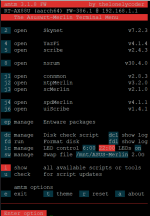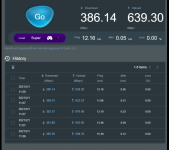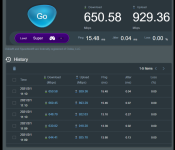AX88U Merlin 386.1, 384.19 and all the beta's in between, 1Gb symmetric fiber, a few scripts including Skynet. In all the testing scenarios at the router, the Windows clients with the app, ~940Mbps down and up. Consistently, which is what matters to me.
I did some extensive testing, controlled as one could control over the internet. Using the same target, 15 runs, averaging out the results. TrendMicro on, any related feature enabled that requires acceptance of the privacy agreement. Cuts my results almost in half with uploads faster than downloads by ~100Mbps. Disable all the TrendMicro related features off, without Skynet, without withdrawing from the TrendMicro Agreement, results matched the Windows Client. With Skynet on, TrendMicro related features disabled but without privacy withdrawn, monitoring only inbound, results matched Windows client. But after about 18 hrs, something triggered TrendMicro and saw my results halved. Only after withdrawing from TrendMicro agreement did my results recover.
Final results with Skynet monitoring inbound and outbound, withdrawn from TrendMicro Privacy agreement, ~920Mbps download, ~650Mbps upload and that's using the same target, and its consistent. Still the Windows client ~940 up/down, and that's where I sit today.
I emphasize, in all testing scenarios, no variations in the client results. I even enabled priority for the Router on the AT&T Modem, no change. I suspect if I was using the modem for anything else but a passthrough for the router I might have seen a difference.
I use spdMerlin to monitor my speeds (uses same Speedtest/Ookla as ASUS) and as long as I am consistent with my results I'm happy regardless of the number result. Ping, Jitter, Packet Loss are more important and impactful to me. If I see a large variation in the trend lines/graph regarding speed results then I'll worry and start checking the devices and other Speedtest targets to see if I get closer to what my ISP provisioned. I'm not hung up with the Router Speedtest results matching what the ISP provisioned.
One thing to look at is router CPU utilization during a Speedtest at the Router vs. (in my case) the windows PC. The impact at the Router is much more pronounced with the Router runs vs the PC runs, as there is a dependency on the CPU of the device running the Speedtest for the Speedtest itself and it will impact your results. Depending on your Router's CPU, features enabled, TrendMicro, what its running (scripts), your selected Speedtest server, and the Internet/carriers your results and mileage will vary.
This is truly Excellent troubleshooting & thank you very-much for sharing your results.
Your Experiences are almost identical to my-own recent findings.
Except that my ISP package limits me to 300/15 & My router is a slower RT-AC68U.
I had recently noticed the correlation between enabling & disabling Trend Micro & opting-out of the privacy agreement.
+ As Others have mentioned (& looking closely at it), Swap file "usage" does seem rather minimal.
@archiel - I think the easiest way to view realtime swap-file use is... "htop".
Install it via: opkg install htop
& run it via : htop
Or, simply type: free -m
for a snapshot of swap & other memory usage.
@TheMorpN - "However, one thing I noticed, and not sure if it makes a difference, my swap file seems to never be used. The GUI shows that I have a swap file, but the router is not storing any files in it.
Is there a way to force SKYNET to use only the router cache? Maybe that would fix it...."
That got me thinking to adjust swappiness & I tried (but I didn't see a notable difference).
via:
sysctl vm.swappiness=60
sysctl vm.swappiness=10
sysctl vm.swappiness=90
sysctl vm.swappiness=0
sysctl vm.swappiness=100
However what I did learn (& myself included) is that swap-file usage is GREATLY misunderstood.
See Busting Myths about Swapiness
Swappiness in Linux has nothing to do with how much RAM is used before swapping starts. We tell you what it really is.

www.howtogeek.com
But regardless... if the swap-file was responsible I still thought the adjustments above should have had a slight impact or made a some-difference, hhmmmmm ???
Anyways in my case...
I'm only using a:
SWAP File; /tmp/mnt/sda1/myswap_1G.swp (1.0G)
total used free
Swap: 1046524 54156 992368
And much like archiel when I have skynet enabled & run tests on a 5g Samsung S8 I can on-average hit the MAX provided throughput of 330 down & 15 up.
But NOT on the Asus RT-AC68U web GUI Ookla Test...
With Skynet & Trend Micro Enabled... Like others its half.
But as I tried to explain above... those numbers are NOT accurate.
What matters is... that the other fast cpu devices in the family &
their speedy cards can hit the MAXIMUM ISP speeds.
And they can.
I don't use our family-laptop's wired ethernet connection plugged into the router because its a crappy 100Mb card & the built-in WiFi is faster... WTF (I know).
Anyways, the teenager has a brand new playstation-5,
I'm curious what numbers it can get, but my bet is +300 no problem.
Anyways even if the swap-file is not to blame...
when looking at the skynet firewall:
FW Version; 386.1_0 (Jan 30 2021) (2.6.36.4brcmarm)
Install Dir; /tmp/mnt/sda1/skynet (26.7G / 31.0G Space Available)
SWAP File; /tmp/mnt/sda1/myswap_1G.swp (1.0G)
The software was installed to my usb-drive & swap is on the usb-drive
So the router & CPU obviously have to access this information periodically.
And the transfer speed is non-steller.
Yes I could UN-install trend micro by opting out, But I also noticed that under skynets [11] settings...
[7] --> Import AiProtect Data | [Enabled]
Perhaps this setting could be Disabled but my other confusion is...
If you opt-out of Trend Micro... Won't Skynet loose access to Trend Micro AiProtect Data?
Point being...
With BOTH enabled, isn't it redundant?
The Final annoyance (I've yet to verify) is...
If you Do NOT Opt-Out from Trend Micro & simply disable via the WebGUI.
Ive read Trend Micro Turns itself BACK-ON.
Thinking about it, Perhaps Its actually the Skynet Setting above which continues using AiProtect.





